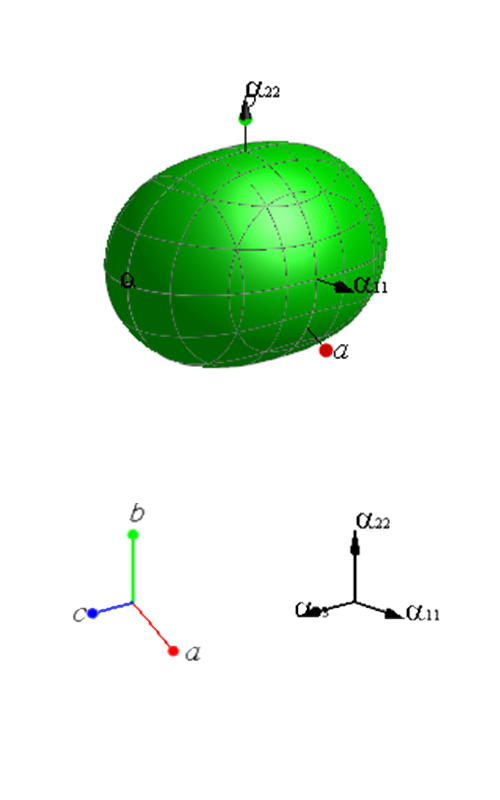Search for new apatite-like phases for lead utilization based on crystal structure and thermal expansion Scientific paper
Main Article Content
Abstract
Apatites, being one of the most numerous mineral-like families of compounds, are considered as a matrix for binding lead ions, which is dangerous for the biosphere. The crystal-chemical (composition, structure) and thermophysical aspects (thermal expansion) are considered as the basis for analysing the properties of this kind of material. It is suggested that substances of the composition Pb5(AIVO4)2(BVIO4), Pb5(AIVO4)(CVO4)2 can be a perspective form of lead binding materials based on compounds with the structure of apatite (AIV = Si, Ge; BVI = S, Cr; CV = P). Such compounds, as it was shown by DTA and HTXRD experiments, are distinguished by the absence of polymerphism and the abnormal ordering of structure. Also, they have relatively low values of thermophysical indicators (the rate of change of linear thermal expansion coefficients is 0.02-0.03∙106 K-1; values of the volume thermal expansion coefficients are 40–70×106 K-1). Compounds Pb5(SiO4)(PO4)2 (a = 9.78782(16) Å, c = 7.31084(16) Å, V = 606.555(23) Å3, R-bragg = 4.694 %) and Pb5(GeO4)(PO4)2 (a = 9.87697(12) Å, c = 7.33136(11) Å, V = 619.388(17) Å3, R-bragg = 1.730 %) were obtained, identified and crystallographically characterized for the first time.
Downloads
Metrics
Article Details

This work is licensed under a Creative Commons Attribution 4.0 International License.

Authors retain copyright and grant the journal right of first publication with the work simultaneously licensed under a Creative Commons Attribution license 4.0 that allows others to share the work with an acknowledgement of the work's authorship and initial publication in this journal.
Funding data
-
Ministry of Science and Higher Education of the Russian Federation
Grant numbers FSWR-2021-014
References
Food and Agriculture Organization of the United Nations, Polluting our soils is polluting our future, https://www.fao.org/fao-stories/article/en/c/1126974/ (accessed: July 22, 2023)
World Health Organization, Lead poisoning, https://www.who.int/news-room/fact-sheets/detail/lead-poisoning-and-health (accessed: July 22, 2023)
L. Chandran, R. Cataldo, Pediatr. Rev. 31 (2010) 399 (https://doi.org/10.1542/pir.31-10-399)
W. A. Martin, S. L. Larson, D. R. Felt, J. Wright, C. S. Griggs, M. Thompson, J. L. Conca, C. C. Nestler, Appl. Geochem. 23 (2008) 34 (https://doi.org/10.1016/j.apgeochem.2007.08.005)
United Nations Environment Programme, Key scientific findings for lead: an excerpt from Final review of scientific information on lead, https://wedocs.unep.org/bitstream/handle/20.500.11822/22871/Key_Scientific_Findings_Lead_RU.pdf?sequence=5&isAllowed=y (accessed: July 22, 2023)
United Nations Environment Programme, Era of leaded petrol over, eliminating a major threat to human and planetary health, https://www.unep.org/news-and-stories/press-release/era-leaded-petrol-over-eliminating-major-threat-human-and-planetary (accessed: July 22, 2023)
J. D. Hopwood, G. R. Derrick, D. R. Brown, C. D. Newman, J. Haley, R. Kershaw, M. Collinge, J. Chem. 2016 (2016) 9074062 (https://doi.org/10.1155/2016/9074062)
I. S. Kasimov, A. E. Vorob’ev, Geochemical barriers in the hypergenesis zone, MSU Publishing House, Moscow, 2002
J. Oliva, J. De Pablo, J. L. Cortina, J. Cama, & C. Ayora, J. Hazard. Mater. 194 (2011) 312 (https://doi.org/10.1016/j.jhazmat.2011.07.104)
M. Katoh, A. Makimura, T. Sato, Environ. Technol. (UK) 37 (2016) 3036 (https://doi.org/10.1080/09593330.2016.1174744)
S. Bailliez, A. Nzihou, E. Bèche, G. Flamant, Process Saf. Environ. Prot. 82 (2004) 175 (https://doi.org/10.1205/095758204322972816)
J. Oliva, J. De Pablo, J. L. Cortina, J. Cama, C. Ayora, J. Hazard. Mater. 184 (2010) 364 (https://doi.org/10.1016/j.jhazmat.2010.08.045)
J. Oliva, J. Cama, J. L. Cortina, C. Ayora, J. De Pablo, J. Hazard. Mater. 213–214 (2012) 7 (https://doi.org/10.1016/j.jhazmat.2012.01.027)
N. G. Chernorukov, A. V. Knyazev, E. N. Bulanov, Inorg. Mater. 47 (2011) 172 (https://doi.org/10.1134/S002016851101002X)
A. V. Knyazev, N. G. Chernorukov, E. N. Bulanov, Mater. Chem. Phys. 132 (2012) 773 (https://doi.org/10.1016/j.matchemphys.2011.12.011)
A. V. Knyazev, E. N. Bulanov, V. Z. Korokin, Mater. Res. Bull. 61 (2014) 47 (https://doi.org/10.1016/j.materresbull.2014.09.089)
E. N. Bulanov, K. S. Stasenko, O. N. Golitsyna, V. M. Kyashkin, A. V. Knyazev, Ceram. Int. 48 (2022) 9858 (https://doi.org/10.1016/j.ceramint.2021.12.188)
M. Mosesman, K. Pitzer, J. Am. Chem. Soc. 63 (1941) 2348 (https://doi.org/10.1021/ja01854a013)
A. A. Coelho, J. Appl. Crystallogr. 51 (2018) 210 (https://doi.org/10.1107/S1600576718000183)
G. Engel, B. Deppisch, Z. anorg. allg. Chem. 562 (1988) 131 (https://doi.org/10.1002/zaac.19885620116)
Atoms, V. 6.1.2, by Shape Software, 2006
R. S. Bubnova, V. A. Firsova, S. K. Filatov, Glas. Phys. Chem. 39 (2013) 347 (https://doi.org/10.1134/S108765961303005X)
K. Nakamoto, Infrared and Raman Spectra of Inorganic and Coordination Compounds, Fourth Edi John Wiley and Sons, Inc., New York, 1986
T. White, C. Ferraris, J. Kim, S. Madhavi, Apatite - an adaptive framework structure, 2018 (https://doi.org/10.2138/rmg.2005.57.10)
R. D. Shannon, Acta Crystallogr., A 32 (1976) 751767 (https://doi.org/10.1107/S0567739476001551)
S. C. Lim, T. Baikie, S. S. Pramana, R. Smith, T. J. White, J. Solid State Chem. 184 (2011) 2978 (https://doi.org/10.1016/j.jssc.2011.08.031)
M. Zhang, E. R. Maddrell, P. K. Abraitis, E. K. H. Salje, Mater. Sci. Eng., B 137 (2007) 149 (https://doi.org/10.1016/j.mseb.2006.11.003)
Z. Zhang, A. Heath, K. T. Valsaraj, W. L. Ebert, T. Yao, J. Lian, J. Wang, RSC Adv. 8 (2018) 3951 (https://doi.org/10.1039/c7ra11049a).





